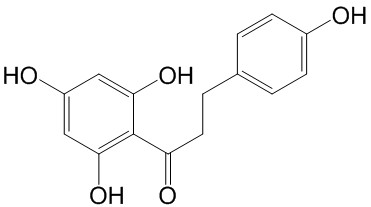Home
Products
Phloretin



| Product Name | Phloretin |
| Price: | $15 / 20mg |
| Catalog No.: | CN05675 |
| CAS No.: | 60-82-2 |
| Molecular Formula: | C15H14O5 |
| Molecular Weight: | 274.3 g/mol |
| Purity: | >=98% |
| Type of Compound: | Chalcones |
| Physical Desc.: | Powder |
| Source: | The peels of apple. |
| Solvent: | Chloroform, Dichloromethane, Ethyl Acetate, DMSO, Acetone, etc. |
| SMILES: | Oc1ccc(cc1)CCC(=O)c1c(O)cc(cc1O)O |
| Contact us | |
|---|---|
| First Name: | |
| Last Name: | |
| E-mail: | |
| Question: | |
| Description | Phloretin(NSC 407292; RJC 02792) is a dihydrochalcone, a type of natural phenols. Phloretin inhibits the active transport of glucose into cells by SGLT1 and SGLT2.IC50 Value: 49 +/- 12 microM [4]Target: SGLT1/2in vitro: Phlorizin blocks glucose transport across the renal tubule at concentrations in renal blood and tissue in the range of 10-5 to 10-7 M [1]. PT significantly enhanced glycerol release and inhibited the adipogenesis-related transcription factors. PT also promoted phosphorylation of AMP-activated protein kinase and increased activity of adipose triglyceride lipase and hormone-sensitive lipase in 3T3-L1 cells [2]. Phloretin induced obvious cytotoxicity against BEL-7402 cells with IC50 of 89.23 microg/mL. The growth curve demonstrated decreased growth of the cells as phloretin concentration increased [3]. D-glucose-transport activity was observed with a Km for D-glucose of 3.4 +/- 0.2 mM (mean +/- S.E.M.) and was inhibited by cytochalasin B (IC50= 0.44 +/- 0.03 microM), HgCl2 (IC50)= 3.5 +/- 0.5 microM), phloretin (IC50= 49 +/- 12 microM) and phloridzin (IC50= 355 +/- 67 microM) [4].in vivo: The effect of phloridzin orally doses 5, 10, 20 and 40 mg/kg body weight on diabetes was tested in a streptozotocin-induced rat model of diabetes type 1. From beneficial effect of this compound is significant reduction of blood glucose levels and improve dyslipidemia in diabetic rats [5]. |
| Density | 1.4±0.1 g/cm3 |
| Boiling Point | 534.4±29.0 °C at 760 mmHg |
| Flash Point | 291.1±20.8 °C |
| Exact Mass | 274.084137 |
| PSA | 97.99000 |
| LogP | 3.50 |
| Vapour Pressure | 0.0±1.5 mmHg at 25°C |
| Storage condition | 2-8°C |